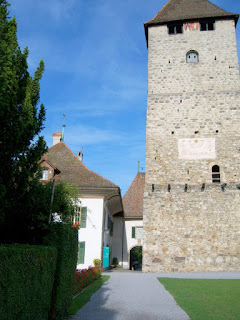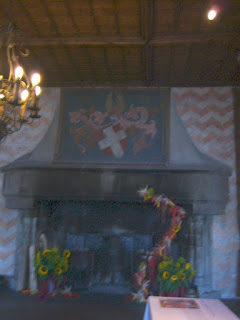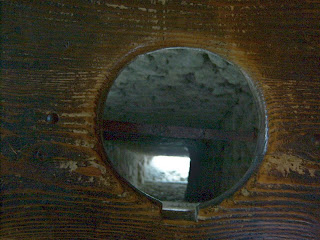Interlaken.
Interlaken is a venerable, old Grand Tour Town between Alpine lakes, with famous peaks - the Junfgrau, the Eiger and the Monch nearby. Some like railroads to get there - The Golden Pass Line, the narrow-gauge railway takes the scenic route from Montreux through Gstaad to Interlaken, see ://www.roughguides.com/website/travel/destination/content/default.aspx?titleid=86&xid=idh558351960_0160/; and ://www.switzerlandflexitours.com/goldenpass-line.html/. You can also take a scenic railway Jungfraujoch Top of Europe. We were running out of time, and will do that next time. Be careful of the high altitudes if you have heart and blood pressure problems. Go to the NYT Archives, Sunday January 19, 2003 at Travel section p. 11 for a fine overview and photos. The Aletsch Glacier is there.
You will probably not stay in Interlaken, however. It has changed.
.
1. Getting there: The Way to Interlaken. In the old days, passage was treacherous: carriages, horseback, mules and donkeys. Here are some donkeys.
.
.
We like the drive. There were more switchbacks, indecipherable signs to the smallest possible destinations rather than a big town on a map that would have been more helpful, but finally we found Gstaad and the ski resort, farms, cliffs, valleys, and - exhausted - Interlaken.
2. The beauty.
Here is the gorgeous view to Lake of Thun, from above Interlaken, the high cliffside route toward Thun, the town.
Switzerland is in the news lately with its recent ban on construction of minarets.
3. Now: Fast forward to Current events, balance of interests. Minarets.
What is the place, in such a place as Interlaken, of tradition and whether tradition should be maintained at the expense of other people's desired architecture for their places of worship. Would minarets here add to, or not, the breathtaking sight.
3,1. Pro: a blanket ban on minarets preserves traditional views that lure tourists, foster a local and national economy, establish identity for its people sharing its history.
3.2. Con: a ban on one group's desired architecture may be too broad. Why not go a lesser route, to impose height restrictions. Minarets are not necessary to the worship, but, like steeples, evolved and serve secular as well as religious-symbolism purposes.
3.3. Require reciprocity. As soon as the homelands of the newer people will foster steeples and churches for Western worship styles (United Arab Republic, for example, permits none) in their countries, then figure out a reciprocal fostering for Eastern worship styles in Western countries.
.
 Lake Thun, Interlaken, Switzerland
Lake Thun, Interlaken, Switzerland
4. How to weigh the issues.
These height/zoning restrictions do not denigrate the Eastern religion, but instead balance the interests of vacationers from other cultures who may want, or do want, to settle, set up their own communities; against the nation's established tourism and the views that produce it.
Explore the issue. See it at ://www.myswitzerland.com/en/destinations/resorts/holiday-destinations-in-switzerland/interlaken.html/. The Bernese Oberland. Aljazeera is wrong to frame the issue as mere misogyny. See ://english.aljazeera.net/focus/2009/12/ 200912281637353840.html/ It is more like Connecticut restricting home construction on mountain ridgelines - have your home, but preserve the view for the rest and, in Switzerland, a country dependent on photography and tourists, for its economic health. Or allow steeples unrestricted in other countries. Would that be fair?
5. Back to Interlaken itself.
Even Rick Steves says not to come here. Or of you do, you will probably stop briefly then move on, as we did. It is a haven for backpackers, and a multitude of ethnic groups those styles of shops etc. have changed the town completely. That need not be a bad thing financially because it looks like the town is prospering, with well-heeled visitors. But it changes what the town means.
- The name of this town, Interlaken, means between two lakes, here the Lake of Thun and the Lake Brienz, in lovely Alpine Switzerland. The name used to mean large Victorian hotels, the Grand Tour of the Uppers, a town where carriageways and private passages by horse and mule (luxury along the way, of course) and trains converged; with the ladies in large hats with huge wooden trunks (the domed steamer trunks were preferred and indicated status, because they had to be at the top of the stack, in the baggage rooms, deep in the steamers coming over the oceans, and were retrieved first; the flat-topped steamer trunks were for others, or for less important accoutrements/ The trunks opened to reveal a side for hanging things, and the other, had drawers for the bloomers).
- We were here in the 1960's - a different family era. It is little like that now, perhaps for the good, but the issue here is an industry. Do a search on Maps - there are no easy roads over to Interlaken - either you take the autobahns going like huge pentagrams from urban center to urban center, Lausanne to Bern and down: or you go over the mountains and through the woods, and after a while, with all the beauty, it gets to be a slog.
6. For us, see Interlaken, but do not expect it to be "Switzerland."
We did the heavy narrow road sneak past the blind turns up and over from Vevey, Montreux, Villeneuve - across, not up easy and down. Dan and I enjoyed a leisurely lunch at the big hotel, still there, tablecloths, people discreetly bowing hither and yon, old days. Go outside, and that atmosphere is no more.
Now, Interlaken is a skeleton.
It has the bones. It offers excellent food, fast service where you may want that, but only the shape is there: Lake Brienz on one side, this little isthmus that is Interlaken, and Lake Thun on the other. The old hotels are still there, but the street levels that used to house fine watches and couture is immigration central, are now fast food, trinkets. Vacation central for all parts of the world.
Enjoy it as the east-west global vacationer magnet that it is. For the old Swiss Switzerland of the Grand Tour, head elsewhere.
 Schlosskirche, Tower, Castle Church, Spiez Castle complex, Swizerland
Schlosskirche, Tower, Castle Church, Spiez Castle complex, Swizerland Schloss Kirche, Castle Church, Spiez, Lake Thun, Switzerland
Schloss Kirche, Castle Church, Spiez, Lake Thun, Switzerland Frescoes, Schloss Kirche, Castle Church, Spiez Castle, Lake Thun, Switzerland
Frescoes, Schloss Kirche, Castle Church, Spiez Castle, Lake Thun, Switzerland Narrow interior door, Castle Church, Schlosskirche, Spiez Castle, Switzerland
Narrow interior door, Castle Church, Schlosskirche, Spiez Castle, Switzerland Altar area view, Spiez, Schlosskirche, Castle Church, Lake Thun, Switzerland
Altar area view, Spiez, Schlosskirche, Castle Church, Lake Thun, Switzerland Bishop's Chair, the "Cathedra", or for other dignitary, Schlosskirche, Castle Church, Spiez Castle, Switzerland
Bishop's Chair, the "Cathedra", or for other dignitary, Schlosskirche, Castle Church, Spiez Castle, Switzerland
 Spiez Castle, residence side, Lake of Thun, Switzerland
Spiez Castle, residence side, Lake of Thun, Switzerland Spiez Castle, Tower, Lake Thun, Switzerland
Spiez Castle, Tower, Lake Thun, Switzerland Woman's armor, among the men's, Chillon Castle, Switzerland, 3d from right.
Woman's armor, among the men's, Chillon Castle, Switzerland, 3d from right. Iron bolt, door, Thun Castle, Switzerland
Iron bolt, door, Thun Castle, Switzerland Medieval Sword, looks about 4-foot in length, to handle. Thun Castle Museum, Switzerland.
Medieval Sword, looks about 4-foot in length, to handle. Thun Castle Museum, Switzerland. Castle tower staircase, winding up to the right.Thun Castle, Switzerland. The defender above had full arm swing down, for the sword. The attacker's right arm, as he fought his way up, would be constricted.
Castle tower staircase, winding up to the right.Thun Castle, Switzerland. The defender above had full arm swing down, for the sword. The attacker's right arm, as he fought his way up, would be constricted.  Woman's armor, Thun Castle, Switzerland.
Woman's armor, Thun Castle, Switzerland.  Suits of men's armor, Thun Castle, Switzerland
Suits of men's armor, Thun Castle, Switzerland Armor for the woman, front angle in context with armor for the man; Thun Castle Museum, Switzerland
Armor for the woman, front angle in context with armor for the man; Thun Castle Museum, Switzerland View across, Castle Thun, Switzerland
View across, Castle Thun, Switzerland Locks, door to prison in tower, Castle Thun, Switzerland
Locks, door to prison in tower, Castle Thun, Switzerland Thun, Manacles, prison in tower, Schloss Thun, Castle Thun, Switzerland
Thun, Manacles, prison in tower, Schloss Thun, Castle Thun, Switzerland View down, Schloss Thun, Castle Thun, Switzerland. Brudermord from here?
View down, Schloss Thun, Castle Thun, Switzerland. Brudermord from here? The Workhorse Chalet, Switzerland
The Workhorse Chalet, Switzerland Chalet-balcony principles, town residence, Thun, Switzerland
Chalet-balcony principles, town residence, Thun, Switzerland Einigen Kirche, Einegen Church, Lake Thun, Switzerland
Einigen Kirche, Einegen Church, Lake Thun, Switzerland Castle Oberhofen, Schloss Oberhofen, Oberhofen am Thunersee, Switzerland
Castle Oberhofen, Schloss Oberhofen, Oberhofen am Thunersee, Switzerland Oberhofen Castle, Tower Detail, Lake Thun, Switzerland
Oberhofen Castle, Tower Detail, Lake Thun, Switzerland Schloss Oberhofen, Gated Entryway, Lake of Thun, Switzerland; Castle Oberhofen
Schloss Oberhofen, Gated Entryway, Lake of Thun, Switzerland; Castle Oberhofen Minaret, mosque, Gibraltar
Minaret, mosque, Gibraltar Thun Castle, view from tower, Switzerland
Thun Castle, view from tower, Switzerland Bruck Castle, view, Lienz, Austria
Bruck Castle, view, Lienz, Austria Women and men's armor, Thun Castle, Switzerland
Women and men's armor, Thun Castle, Switzerland Crusades: A Curiosity Now. But See Crusades as a Religious, Theological, Political Disaster Then. Also now. Templars at Malbork, Poland.
Crusades: A Curiosity Now. But See Crusades as a Religious, Theological, Political Disaster Then. Also now. Templars at Malbork, Poland.  Donkeys, farm en route Montreux to Interlaken, Switzerland
Donkeys, farm en route Montreux to Interlaken, Switzerland Lake of Thun, high cliff road Interlaken to Thun (town)
Lake of Thun, high cliff road Interlaken to Thun (town) Lake Thun, Interlaken, Switzerland
Lake Thun, Interlaken, Switzerland Chillon Castle, Switzerland, the Duke Emerges From His Bath
Chillon Castle, Switzerland, the Duke Emerges From His Bath Chillon Castle, black figures, unknown reference
Chillon Castle, black figures, unknown reference Motto: "Learning to observe is learning to respect." Whom from, pray tell?
Motto: "Learning to observe is learning to respect." Whom from, pray tell? Chillon Castle, Switzerland, Vincent Freisching? Black and White in Heraldry. St. Vincent?
Chillon Castle, Switzerland, Vincent Freisching? Black and White in Heraldry. St. Vincent? Chillon Castle, Black and White heraldry (blurred - life is tough)
Chillon Castle, Black and White heraldry (blurred - life is tough) Santa Claus in Heraldry, Frederic de Gingins, at Chillon Castle, Switzerland. Santa here. Yes, Santa.
Santa Claus in Heraldry, Frederic de Gingins, at Chillon Castle, Switzerland. Santa here. Yes, Santa. Black Madonna, ceiling (fresco or painting?) Chillon Castle, Switzerland (and black child)
Black Madonna, ceiling (fresco or painting?) Chillon Castle, Switzerland (and black child) Security checkpoints, Castle Chillon, defenses.
Security checkpoints, Castle Chillon, defenses. Clothing chests, or other household goods, wooden-carved, Chillon Castle, Switzerland
Clothing chests, or other household goods, wooden-carved, Chillon Castle, Switzerland Religious theme: Adam and Eve and, oh, no, a female snake (the Bible says the snake was a "he"); all the better for dogma, my dear. Castle Chillon, Switzerland
Religious theme: Adam and Eve and, oh, no, a female snake (the Bible says the snake was a "he"); all the better for dogma, my dear. Castle Chillon, Switzerland Women in War. Woman's armor? Chillon Castle collection, second from left, Switzerland
Women in War. Woman's armor? Chillon Castle collection, second from left, Switzerland Fireback, Chillon Castle, Switzerland
Fireback, Chillon Castle, Switzerland Bed, Chillon Castle, Switzerland; portable. Guide said Duke took furnishings with him castle to castle.
Bed, Chillon Castle, Switzerland; portable. Guide said Duke took furnishings with him castle to castle. Roofed battlements structure, post and beam, Chillon Castle, Lake Geneva, Switzerland
Roofed battlements structure, post and beam, Chillon Castle, Lake Geneva, Switzerland Large medieval fireplace with overhang, not heat-efficient, Chillon Castle, Switzerland
Large medieval fireplace with overhang, not heat-efficient, Chillon Castle, Switzerland Castle Chillon, an island now bridged, Lake Geneva, Switzerland
Castle Chillon, an island now bridged, Lake Geneva, Switzerland Chillon Castle, View from the Prison at water level,above an unloading dock, Lake Geneva, Switzerland
Chillon Castle, View from the Prison at water level,above an unloading dock, Lake Geneva, Switzerland Courtyard and fortified storage area, perhaps prison off and on, Castle Chillon, Switzerland
Courtyard and fortified storage area, perhaps prison off and on, Castle Chillon, Switzerland Outer walls, Chillon Castle, Switzerland
Outer walls, Chillon Castle, Switzerland Escape hatch or treasure storage? Put a rug on top. Chillon Castle, Switzerland
Escape hatch or treasure storage? Put a rug on top. Chillon Castle, Switzerland Passageway door, to area between walls; too narrow for armor, just slip in and slip out, Castle Chillon, Switzerland. Boudoir? Council room? We recall boudoir. Check for us.
Passageway door, to area between walls; too narrow for armor, just slip in and slip out, Castle Chillon, Switzerland. Boudoir? Council room? We recall boudoir. Check for us. Folding stairs, castle defense, Castle Chillon, Switzerland
Folding stairs, castle defense, Castle Chillon, Switzerland Courtyard staircase to battlements, Chillon Castle, Switzerland
Courtyard staircase to battlements, Chillon Castle, Switzerland Tower-top prison room, with manacles, Chillon Castle, Switzerland
Tower-top prison room, with manacles, Chillon Castle, Switzerland Castle toilet. Garderobe. A one-holer, lookig down to lake. The necessary. Chillon Castle, Switzerland. Also useful for invading climbers. Look before you sit.
Castle toilet. Garderobe. A one-holer, lookig down to lake. The necessary. Chillon Castle, Switzerland. Also useful for invading climbers. Look before you sit. Chimney pots, baffles for cinders from fireplaces, Chillon Castle, Switzerland>
Chimney pots, baffles for cinders from fireplaces, Chillon Castle, Switzerland> A two-holer, more Necessaries, Chillon Castle, Switzerland (with guard)
A two-holer, more Necessaries, Chillon Castle, Switzerland (with guard) A two-holer with arrow slit above for defense when not otherwise in use, Chillon Castle, Switzerland
A two-holer with arrow slit above for defense when not otherwise in use, Chillon Castle, Switzerland Chillon Castle tourist who thinks sensible castle plumbing is fun
Chillon Castle tourist who thinks sensible castle plumbing is fun Not fun. Torture table. Chillon Castle, Switzerland
Not fun. Torture table. Chillon Castle, Switzerland